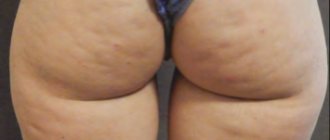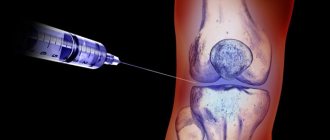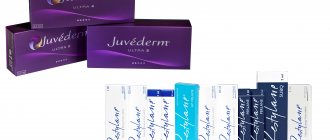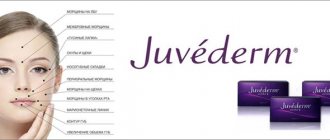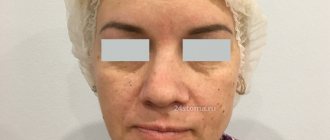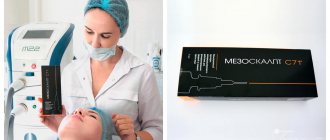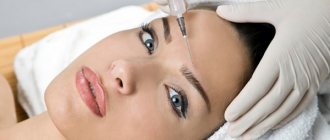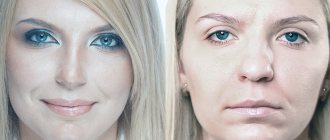It is possible to lift the corners of the lips with Botox, but to be precise, more often Botox is injected into the corners of the lips not to lift them, but to stop them from drooping.
Function of the depressor anguli oris muscle
If folds like those in the picture do not constantly exist on the face, but appear during a conversation or even when smiling, this indicates hyperactivity of the depressor anguli oris muscle. In Latin it is called musculus Depressor Anguli Oris, so in the literature it is often called DAO for short. And Botox can perfectly eliminate this not very beautiful facial expression, along with unnecessary folds.
modiolus
True, injecting into the very corners of the lips is risky. Several muscles are intertwined there, responsible for the subtle facial expressions of a smile, and the introduction of botulinum toxin into this area will most likely turn off not only DAO, but also other muscles, which leads to smile distortions, “shark smile” and other passing, but not very beautiful things.
depressor anguli oris muscle
Our target is only the DAO, the depressor anguli oris muscle. It goes from the corner of the mouth downwards, fanning out slightly. And when choosing an injection point, we are guided by its anatomy.
Rules for Botox injections into the corners of the lips
- We go lower - about 1/3 of the height of the gap from the edge of the lower jaw to the corner of the mouth. In this case, you should not focus on the folds.
- Let's not move towards the middle. There, from under the DAO, the muscle that lowers the lower lip peeks out, and if you turn it off, we get a distortion when smiling. Therefore, it is better to move a little to the side - there are no “dangerous” muscles there.
- Kohl is superficial. The muscles here lie in several layers, like a sandwich. DAO lies at the top - immediately under the skin, so in order for the drug to get into it and not affect its neighbors, there is no need to go deeper, you can inject it intradermally.
- The dose of botulinum toxin should be small. 1-2 units of Botox, 3-5 Dysport on each side is enough for most. If this is not enough, it is better to adjust it after 2 weeks and add another drop.
Of course, these are just the basic rules, to which there are always exceptions. Sometimes you need to inject lower, sometimes at the very corner of the mouth, sometimes at 2 points - one lower, one higher - otherwise it doesn’t work at all.
The indicated number of units of Botox is not enough for everyone, and you have to experiment until you find an individual dose. With experience, the dose and point of the beautician begins to guess more often the first time, but to begin with it is better to adhere to the basic rules, of which the main thing is not to overdo it with the dose, it is better to do it twice than to distort your smile once!
Description of the procedure – correction of lip angles
In order to correct drooping corners of the lips, medium-density substances are usually used, which are specially designed for contouring (Juvederm Volbella, Surgiderm 30 XP, Belotero Basic, Surgiderm 24 XP, Juvederm Ultra 3). Depending on the condition of the skin and how drooping the corners are, the required volume of gel is determined; most often, from 0.2 to 0.5 ml is needed.
- The injection area is moistened with a disinfectant composition (miramistin, chlorhexidine or others).
- Anesthesia is performed. Without this, the procedure can also be carried out, only it will be somewhat more sensitive, but only slightly. Superficial anesthesia using a cream allows the introduction of the gel to be more comfortable for the client. If you use plastic gels that contain lidocaine in the formulation (for example, such as Juvederm Ultra and its analogues), the injection will become even more invisible.
- The gel is injected.
- After the procedure is completed, there will be some swelling, but only a little. Secondary treatment with a disinfectant composition occurs. Then a relaxing cream is applied (usually such as Traumeel S and the like).
Within fifteen minutes after the injection, the folds will begin to fill, taking the desired shape and desired volume.
Botox problems in this area
If everything is done correctly, the effect is like this:
Botox in the corners of the lips: before and after
Despite the simple protocol and small dosage, this is one of the most complex procedures in botulinum therapy. In general, the entire area around the mouth is not simple. This is due to the multi-layered muscle “sandwich”.
Even when administered according to all the rules, with the utmost care, Botox can spread and fall on neighboring muscles, causing unnecessary changes in facial expressions - when smiling or when talking. Of course, proper dilution and administration of the drug, plus experience, reduce the risk of these adverse reactions as much as possible, but according to our observations, it is still about 5% . Compared to the forehead-between the eyebrows, this is a LOT.
If such consequences occur, they usually do not last long and can often be corrected by introducing Botox to other points. But if you have some super-important event coming up, be sure to tell your doctor about it. It is better to have at least a month in reserve, especially for the first time.
Problems with using botulinum toxin to lift the corners of the lips
All of the above recommendations are due to the need to avoid possible complications that can result from botulinum toxin injections into the depressor anguli oris muscle. This is due, first of all, to the multi-layered muscles in the area around the mouth. The injected drug can quite easily spread and penetrate into neighboring muscles, as a result of which various changes may occur during a conversation, smile or any other facial expression. The injection of botulinum toxin to lift the corners of the lips is one of the most difficult procedures in aesthetic botulinum therapy, which is why it is necessary to work in this area very carefully, with a good understanding of the anatomy of this area.
What else can you do to raise the corners of your lips?
Filers
If you need to lift the corners of your lips more strongly or the wrinkles are no longer dynamic (only with facial expressions), but static - permanent, then Botox can be supplemented with injections of hyaluronic fillers using a special technique, but this should not be done in one procedure. It is better to wait a couple of weeks for the botulinum toxin reaction to subside. Then you can see how much and where hyaluronic acid needs to be injected, and whether it is necessary at all. It costs more than Botox, but there are fewer potential problems. The main risk is hematomas at the injection site.
Enlargement, correction of asymmetry, lifting the corners of the lips
Threads
For very difficult cases - spring threads. These are Russian Aptos Spring and French Spring Thread. They are often confused with spring mesothreads; this is at all . Mesothreads are many times weaker, and if they give a lifting effect, it is only for a short time.
springs for the corners of the mouth Aptos Spring (blue lines - markings before installation)
Hematomas often occur during installation, so time in reserve to bring oneself into a “ceremonial” appearance should be provided.
See what else you can do with Botox on your lips here >>
What is the difference between Botox and fillers?
If you wondered what muscles have to do with it, then there is an answer. The lips are one of the sphincters, a kind of muscle nodes that should block or change the shape of the holes in the body. The work of sphincters depends on certain muscle groups. This is why Botox injections are not given into the lips themselves - this will lead to them losing their functions. Injections are made along the contour, so that they act on the peripheral muscles, which are not so important for the lips themselves.
Lip contouring using fillers is the introduction of fillers into the tissue, fillers that will maintain the shape of the lips and their volume for some time. Do not confuse fillers with implants - a drug based on hyaluronic acid is not a foreign “insert,” which means that after some time the filler will begin to disintegrate and be removed from the body. After about a year, or even earlier, you will notice that the shape of your lips again requires correction.
Are there more radical types of lip correction that do not require repeated administration of specific drugs? Plastic surgery has methods for restoring shape - this is a circular facelift, which together gives the overall effect of smoothness and elasticity of the skin. It can be successfully combined with other forms of correction, achieving a visual “rejuvenation” effect - for example, eyelid blepharoplasty can remove wrinkles and folds and change the appearance of the eyes.
Truths and myths about Botox
Having once read a forum about “ Botox ,” I was horrified by the absolute ignorance of patients about this procedure and decided to debunk many myths and tell the whole truth.
Myth No. 1. Botox is poison.
Truth: Botulinum toxin is truly one of the strongest organic poisons. But the maximum allowable dosage for cosmetic procedures is 3000 times less than the toxic one. Therefore, it is simply impossible to get poisoned during the botulinum therapy .
Myth No. 2. After the Botox procedure, it may become distorted.
Truth: any cosmetic procedure can have complications that are caused either by the drug administered or by improper actions of the doctor. Complications after botulinum toxin are mainly the result of violations of the administration technique and dosage of the drug, as well as non-compliance with the doctor’s recommendations in the post-procedure period.
Botulinum toxin injections are performed intramuscularly in the optimal dosage. When the drug is administered or migrates not into adjacent muscles, complications arise such as: ptosis of the upper eyelid (when correcting the area between the eyebrows), drooping eyebrows (correction of forehead wrinkles), blurred vision (correction of “crow’s feet”), ptosis of the lower lip (raising the corners of the mouth) , disorders of the swallowing process (correction of platysma bands), etc.
Migration of the botulinum toxin is also possible if the recommendations are not followed to maintain a vertical position for at least 4 hours after the procedure and make active movements of the corrected muscles for 30 minutes.
In rare cases, migration of “ Botox ” is possible due to the individual characteristics of the anatomical structure. Fortunately, all these troubles are reversible and go away in 2-3 weeks at best, or with the cessation of the drug’s effect at worst.
If the botulinum therapy is carried out in a licensed clinic, by a certified cosmetologist and the drug is purchased from an official distributor in the Russian Federation, and the optimal dosage has been selected, which depends on the size and strength of the muscles, then there can be no complications.
In addition to complications, side effects are possible after botulinum toxin : bruises (needle injury), headache, blurred vision (diplopia) and facial expressions (redistribution of muscle load between target and antagonist muscles), swelling (impaired drainage due to muscle weakness (more often at high doses), flu-like syndrome (reaction of the immune system). All these phenomena disappear within a maximum of 2 weeks.
Myth No. 3. After a Botox injection, the muscles atrophy and the skin becomes sagging.
Truth: A muscle that is paralyzed for several months actually loses some of its volume. But it is so small that this can only be determined with the help of special equipment, but not visually. In addition, as soon as muscle activity begins to recover, muscle volume is restored.
You just shouldn’t rush to another botulinum therapy when the effect of the previous one has waned; you need to give the muscle time to recover. Botox injections is 7-8 months.
As for the skin, it has recently been proven that its condition improves with botulinum toxin . This is due to the fact that constant restoration processes take place in muscle tissue (the body eliminates the effects of botulinum therapy ), which significantly improves metabolic processes in adjacent tissues.
The only thing that can happen is that the skin may “hang” when correcting a “square” jaw. Botulinum toxin is injected into the overly large and strong masticatory muscle, which gives rise to sharp angles of the lower jaw. The decrease in the volume of this muscle is quite large, which is why skin ptosis is possible. But a competent cosmetologist, anticipating this, will definitely prescribe lifting procedures (RF-lifting, Martix RF, Restylane Vital) and will correct this area in small doses to avoid a sharp loss of volume.
Myth No. 4. You can’t do Botox at a young age, the later the better, otherwise it will become addictive or it will become even worse than before.
Truth: The indication for botulinum therapy is facial wrinkles, not age. And facial activity does not depend on age. It happens that a young girl has such strong facial expressions that by the age of 30 her face will be covered with a network of deep wrinkles, which are almost impossible to correct. Therefore, if you see that furrows are forming in place of wrinkles that previously took place in a relaxed state, without looking in the “date of birth” column in your passport, rush to see a cosmetologist.
botulinum therapy for older patients with excess skin even before intensive anti-aging therapy to correct ptosis. As for “addiction” and insensitivity, this does not occur very often. This is the result of your immune system. It produces antibodies to botulinum toxin and neutralizes it immediately upon entering the body. The solution can be found in changing the drug. One of the latest drugs to appear on our market is “ Xeomin ”. It is slightly different in molecular structure from other drugs, so it is not “recognized” by the immune system. True insensitivity to botulinum toxin occurs in 0.1% of cases.
But there is also a positive “addiction”. During the time that the muscle does not work, you lose the habit of this facial expression (you stop frowning, squinting, raising your eyebrows high, etc.). This allows botulinum toxin even less frequently. Therefore, it definitely cannot become worse than it was.
Myth No. 5. Botox on the lips?!
Truth: This phrase alone makes me shudder. Botulinum toxin causes paresis of the muscle into which it was injected, so if it is injected into the lips, and therefore into the orbicularis oris muscle, the consequences are scary to even imagine. To change the shape and volume of the lips, hyaluronic acid preparations are used (Restylane, Restylane Lip, Juvederm, Juvederm Valift, etc.). Botulinum toxin in the lower third of the face is used to eliminate “purse-string” wrinkles around the lips (with very low dosages and very superficially), as well as to lift the corners of the lips (injections into the depressor anguli oris muscle). Even lower, you can correct jowls, vertical bands on the neck and uneven chin.
In our age of information technology and media, when all sources trumpet how someone was disfigured, many find it difficult to believe in the true effect of “beauty injections.” When everything is good, you can’t find information about it on the forums, they don’t make reports, but they should. Tell me how the wrinkles on the forehead disappeared, and the eyebrows rise, when you smile, barely noticeable folds appear in the corners of the eyes, which are not present in a calm state, there is no frown and the appearance of a face preoccupied with heavy thoughts, the corners of the lips look up, not down, forming a Pierrot mask, disappeared a “correct” smile (with too much exposed denim), vertical folds on the neck and wrinkles in the décolleté area have disappeared, scars after operations, burns have become less pronounced, and much more.
botulinum therapy should not cause panic Do not skimp on botulinum toxin , do not contact dubious specialists and then you will not be included in the list of complications!
Book your consultation and procedure online here
In previous parts we talked about the clinical use of BOTOX in cosmetology. Today's conversation will be devoted to the history of the study of botulism toxin and the action of the drug BOTOX at the molecular level. For many readers, this will be the answer to the question: “What are they injecting us with – poison or not poison?”
Botulism has been known to the world for a thousand years, but only in 1895 was the microorganism identified that causes this disease, which begins after eating low-quality meat products and canned food. The microorganism was first called the botulism bacillus (from the Latin botulus - “black sausage”), and in 1922 it was renamed clostridium botulism (clostridium means anaerobic, i.e. the absence of oxygen is important for its life). Clostridium botulism synthesizes waste products that cause a disease expressed in muscle paralysis up to complete immobilization.
In 1946, American microbiologist and toxicologist Edward Shantz obtained an isolated crystalline form of the toxin. Studying its action, scientists found that muscle paralysis, that is, lack of movement, in botulism is not caused by damage to muscle tissue, but only by the fact that the signal to contract did not reach the muscle as a result of blockade of the transmission of nerve impulses. The muscle tissue itself remains unharmed, and when the impulse is restored, the muscle works again.
It was then that doctors realized that a unique drug had been found that could combat spasticity - an involuntary increase in muscle tone. This pathology is characteristic of diseases such as cervical dystonia, cerebral strokes, traumatic brain and spinal injuries, cerebral palsy and multiple sclerosis, in which spasm of a muscle group occurs until it is impossible to relax them. Manifestations of spasticity are unpleasant not only due to pain, discomfort in a forced posture, and movement disorder. If such a spasm exists for a long time, irreversible changes occur in the muscles, tendons and joints. As a result, the patient becomes disabled.
Botulinum toxin's ability to relax muscles could be useful in treating spasticity. How? An impulse is constantly transmitted from the brain or motor neurons of the spinal cord, leading to muscle contraction. We cannot stop this process either at the level of the brain or at the muscle level. But there is a small space between the very last point of the nerve terminal (the presynaptic membrane) that carries the impulse from the brain to the muscle, and the very first point in the muscle that encounters this signal (the postsynaptic membrane). This is the neuromuscular junction. This is where you can block the transmission of impulse to the muscle with BOTOX.
Acetylcholine is constantly synthesized in the presynaptic nerve terminal, which binds to the postsynaptic membrane and causes muscle contraction. It is delivered to the presynaptic membrane by transport proteins, the main one of which is SNAP-25. It is this protein that serves as a target for the BOTOX molecule, which breaks it down and thereby makes it impossible for acetylcholine to enter the synaptic cleft and muscle contraction itself. This process occurs in the presynapse of the nerve terminal, and as a result, the muscle tissue remains unchanged. After 5–6 months, rarely after a year, muscle contraction is restored. Studies have shown that even multiple (more than 30) injections into the same place do not cause atrophy of either nerve or muscle. The entire toxicity of the molecule, when administered precisely at one point in the muscle, manifests itself only at the level of transmission of the nerve impulse to this muscle. The toxin does not spread anywhere from the injection site, does not damage the kidneys and is not absorbed into the brain.
The first Oculinum toxin preparation for the treatment of strabismus received approval for clinical use in 1982, and by the end of the 80s it began to be actively used for blepharospasm and spasmodic torticollis. Soon it became a universal remedy for the treatment of local muscle spasms of various natures, hyperhidrosis (excessive sweating) and the correction of cosmetic problems. In 1989, the monopoly right to produce and distribute the drug, which in 1992 became known as BOTOX, was obtained by the American company Allergan.
In our country, the percentage of BOTOX used for cosmetic and other therapeutic purposes is 80: 20, and in Europe and America - 20: 80. The fact is that this drug is very expensive. Abroad, BOTOX treatment is paid for by insurance companies from quotas allocated by the state. There are no such programs in our country yet, but the drug has been registered in Russia since 1995 and is successfully used in neurology and pediatrics.
Here is a medical story about another poison tamed by man. And every patient has the right to decide whether to use BOTOX or not. As well as the right to know reliable information, often distorted by the media. But since nature has given us such a wonderful molecule that can both take away movement and return it, it needs to be studied and used. Always use with caution, under professional supervision and with great gratitude to those people who saw in time and gave the world a powerful evil that works wonders in a homeopathic dose.
